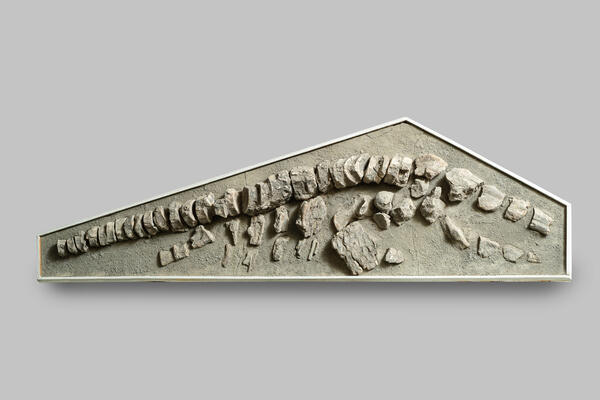The Department of Nature has a hall dedicated to the geological and paleontological history of the Earth. It houses a well-preserved ichthyosaur skeleton.
It was discovered by geologist Maria Matesova on the banks of the Volga River near the village of Shiroky Buyerak in the Volsky district. The remains were laid out on a sand-cement base in the order in which they were arranged in the ichthyosaur.
In total, 60 scattered bones of the ichthyosaur skeleton were found: 30 partly preserved vertebrae and separate bones of other parts of the skeleton. These fragments were extracted from the grey clays of the Aptian and Albian stages of the Early Cretaceous.
The Albian is a period that started 113 million years ago and ended 100.5 million years ago. It was preceded by the Aptian that started 125 million years ago. Fossilized mollusks — ammonites and belemnites, as well as spores of various plants and pollen are usually found in the sediments of this age.
Ichthyosaurs are an order of extinct marine reptiles that are similar to modern fish and dolphins in body shape. They lived during the Mesozoic Era — between 230 and 70 million years ago.
These creatures were quite large — their bodies reached up to two meters in length. Ichthyosaurs are considered the most adapted to the aquatic lifestyle among the creatures of their time. They had long snouts, very large eyes protected by a bony ring, limbs transformed into flippers, and strongly concave vertebrae.
Their fins and a tail with two lobes helped them maintain balance and choose the direction of movement. However, the key evolutionary feature of ichthyosaurs was viviparity: females gave birth to live young in the aquatic environment.
Ichthyosaurs mostly hunted at night due to their large eyes and probably, skin receptors similar to the so-called lateral line. It helps modern fish and amphibians perceive water fluctuation. Ichthyosaurs ate mollusks — ammonites, nautiloids, and squids and could hunt smaller reptiles and the ancestors of modern fish. Their teeth changed several times during their life.
Scientists suppose that ichthyosaurs became extinct mostly due to global warming which was in the middle of the Cretaceous. At that time, the concentration of oxygen in seawater decreased, and ichthyosaurs could not adapt to these changes.
It was discovered by geologist Maria Matesova on the banks of the Volga River near the village of Shiroky Buyerak in the Volsky district. The remains were laid out on a sand-cement base in the order in which they were arranged in the ichthyosaur.
In total, 60 scattered bones of the ichthyosaur skeleton were found: 30 partly preserved vertebrae and separate bones of other parts of the skeleton. These fragments were extracted from the grey clays of the Aptian and Albian stages of the Early Cretaceous.
The Albian is a period that started 113 million years ago and ended 100.5 million years ago. It was preceded by the Aptian that started 125 million years ago. Fossilized mollusks — ammonites and belemnites, as well as spores of various plants and pollen are usually found in the sediments of this age.
Ichthyosaurs are an order of extinct marine reptiles that are similar to modern fish and dolphins in body shape. They lived during the Mesozoic Era — between 230 and 70 million years ago.
These creatures were quite large — their bodies reached up to two meters in length. Ichthyosaurs are considered the most adapted to the aquatic lifestyle among the creatures of their time. They had long snouts, very large eyes protected by a bony ring, limbs transformed into flippers, and strongly concave vertebrae.
Their fins and a tail with two lobes helped them maintain balance and choose the direction of movement. However, the key evolutionary feature of ichthyosaurs was viviparity: females gave birth to live young in the aquatic environment.
Ichthyosaurs mostly hunted at night due to their large eyes and probably, skin receptors similar to the so-called lateral line. It helps modern fish and amphibians perceive water fluctuation. Ichthyosaurs ate mollusks — ammonites, nautiloids, and squids and could hunt smaller reptiles and the ancestors of modern fish. Their teeth changed several times during their life.
Scientists suppose that ichthyosaurs became extinct mostly due to global warming which was in the middle of the Cretaceous. At that time, the concentration of oxygen in seawater decreased, and ichthyosaurs could not adapt to these changes.



